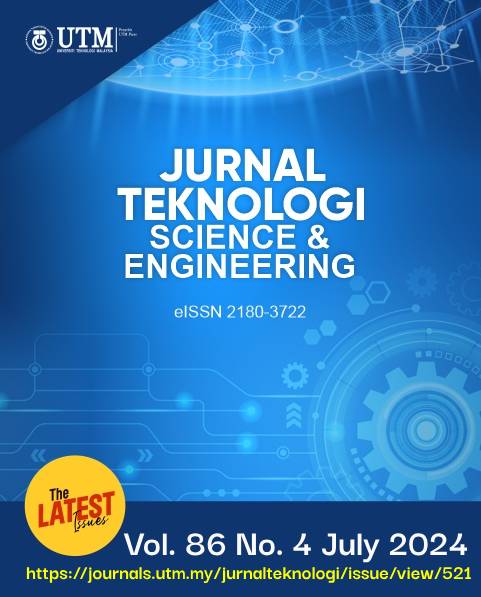ADAPTIVE CONTROL OF A SUBMARINE FOR VARIOUS DIVING DEPTHS USING AN EXPONENTIAL FUNCTION
DOI:
https://doi.org/10.11113/jurnalteknologi.v86.21383Keywords:
Adaptive control, analytical controller, Monte Carlo simulationAbstract
Due to the progress of deep submergence capabilities, a submarine is extensively employed on many sides of marine science. For that reason, it has become necessary to design an effective submarine position controller while achieving a fast and stable mission. An adaptive analytical scheme for the underwater submarine was developed. The main purpose of the adaptive analytical scheme is to provide a powerful analytical controller that can successfully steer the submarine from the current state under the water to the surface of water in a short time. To achieve that, a seventh-term exponential function was proposed to reshape the reference diving depth while maintaining the control variable limitation and satisfying initial and final boundary conditions. The direct search method with two cascade loops was employed to achieve a minimum cost function by determining an appropriate constant of the function and minimum final time. However, using the direct search method can be time-consuming since a number of algebraic operations are executed inside these two loops. Therefore, the curve fitting method was used to fit the set of direct search method data using power functions. Then, at a certain diving depth, the function coefficients were computed based on the final settling time and function constant using the Gaussian elimination method. A nominal numerical simulation of the submarine’s model was implemented using both adaptive analytical and linear controllers.
References
A. J. Healey and D. Lienard. 1993. Multivariable Sliding Mode Control for Autonomous Diving and Steering of Unmanned Underwater Vehicles. IEEE Journal of Oceanic Engineering. 18(3): 327-339. Doi: 10.1109/JOE.1993.236372.
Alex, P., Shtessel, Y. B. and Gallegos, C. J. 2003. Min-max Sliding-mode Control For Multimodel Linear Time Varying System. IEEE Transaction on Automatic Control. 48(12): 2141-2150.
Ahmed Rhif. 2014. Sliding Mode-multimodel Stabilizing Control using Single and Several Sliding Surfaces: Simulation on an Autonomous Underwater Vehicle. Int. J. Modelling, Identification and Control. 22(2).
Subudhi, B., Mukherjee, K. and Ghosh, S. 2013. A Static Output Feedback Control Design for Path Following of Autonomous Underwater Vehicle in Vertical Plane. Ocean Eng. 63: 72-76.
Zhang, L. J., Qi, X. and Pang, Y. J. 2009. Adaptive Output Feedback Control based on DRFNN for AUV. Ocean Eng. 36: 716-722.
Xu, J., Wang, M., Zhang, G. 2015. Trajectory Tracking Control of an Underactuated Unmanned Underwater Vehicle Synchronously Following Mother Submarine without Velocity Measurement. Advances in Mechanical Engineering. 7(7). Doi:10.1177/1687814015595340.
E. Licéaga-Castro, J. Licéaga-Castro, C. E. Ugalde-Loo, E. M. Navarro-López. 2008. Efficient Multivariable Submarine Depth-control System Design. Ocean Eng. 35: 1747-1758.
Petrich, J. and Stilwell, D. J. 2011. Robust Control for an Autonomous Underwater Vehicle that Suppresses Pitch and Yaw Coupling. Ocean Eng. 38(1): 197-204.
Lee, K. W., Singh, S. N. 2014. Multi-input Submarine Control via ℒ1 Adaptive Feedback Despite Uncertainties. Proceedings of the Institution of Mechanical Engineers, Part I: Journal of Systems and Control Engineering. 228(5): 330-347. Doi:10.1177/0959651813515206.
Sutton, G. J., Bitmead, R. R. 2000. Performance and Computational Implementation of Nonlinear Model Predictive Control on a Submarine. In: Allgöwer, F., Zheng, A. (eds). Nonlinear Model Predictive Control. Progress in Systems and Control Theory. 26. Birkhäuser, Basel. https://doi.org/10.1007/978-3-0348-8407-5_27.
Y. Li, F. Li, W. Wang and J. Ju. 2012. Study on Auto Disturbance Rejection Controller for Submarine Depth Control Systems. 2012 Fifth International Symposium on Computational Intelligence and Design, Hangzhou, China. 181-183. Doi: 10.1109/ISCID.2012.53.
Liceaga-Castro, E., and G. Van Der Molen. 1995. A Submarine Depth Control System Design. International Journal of Control. 61(2): 279-308.
Al-Bakri, Fawaz F., Hasan H. Ali, and Kafaji Salwan Obaid Waheed. 2021. A New Analytical Control Strategy for a Magnetic Suspension System under Initial Position Dispersions. FME Transactions. 49(4): 977-987.
Ali, Hasan H., Fawaz, F. Al-Bakri, and Salwan Obaid Waheed Khafaji. 2023. Analytical Position Control System of a Linear Hydraulic Actuator Used in Aircraft Applications. International Journal. 13(2023): 209.
Al-Bakri, Fawaz F., Salwan Obaid Waheed Khafaji, and Hasan H. Ali. 2021. A Novel Analytical Control of a Single Rotary Inverted Pendulum under Initial Angular Dispersions. International Journal of Mechatronics and Applied Mechanics. 10(2021): 32-42.
MacLin, G., Hammond, M., Cichella, V. and Martin, J. E., 2024. Modeling, Simulation and Maneuvering Control of a Generic Submarine. Control Engineering Practice. 144: 105792.
Lefort, A., Dal Santo, X., Ninin, J. and Clement, B. 2018. Depth Control of a Submarine: An Application of Structured H∞ Synthesis Method for Uncertain Models based on Interval Analysis. 2018 Australian & New Zealand Control Conference (ANZCC), IEEE. 269-274.
J. Adamy, Jürgen. 2022. Nonlinear Systems and Controls. Springer Nature.
Onnermark, J. 1976. URF, The Swedish Rescue Submarine-Special Design Features. OCEANS'76, IEEE. 618-623.
Gutman, Per-Olof, and Per Hagander. 1985. A New Design of Constrained Controllers for Linear Systems. IEEE Transactions on Automatic Control. 30(1): 22-33.
Al-Bakri, Fawaz F., Sarah K. Lami, Hasan H. Ali, and Salwan Obaid Waheed Khafaji. 2021. A Sliding Mode Control of an Electromagnetic Actuator Used in Aircraft Systems. 2021 5th Annual Systems Modelling Conference (SMC), IEEE. 1-5.
Al-Bakri, Fawaz F., Salwan Obaid Waheed Kafaji, and Hasan H. Ali. 2022. Adaptive Model Predictive Control for a Magnetic Suspension System under Initial Position Dispersions and Voltage Disturbances. FME Transactions. 50(1): 211-222.
Downloads
Published
Issue
Section
License
Copyright of articles that appear in Jurnal Teknologi belongs exclusively to Penerbit Universiti Teknologi Malaysia (Penerbit UTM Press). This copyright covers the rights to reproduce the article, including reprints, electronic reproductions, or any other reproductions of similar nature.
















